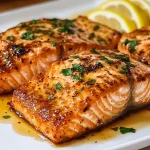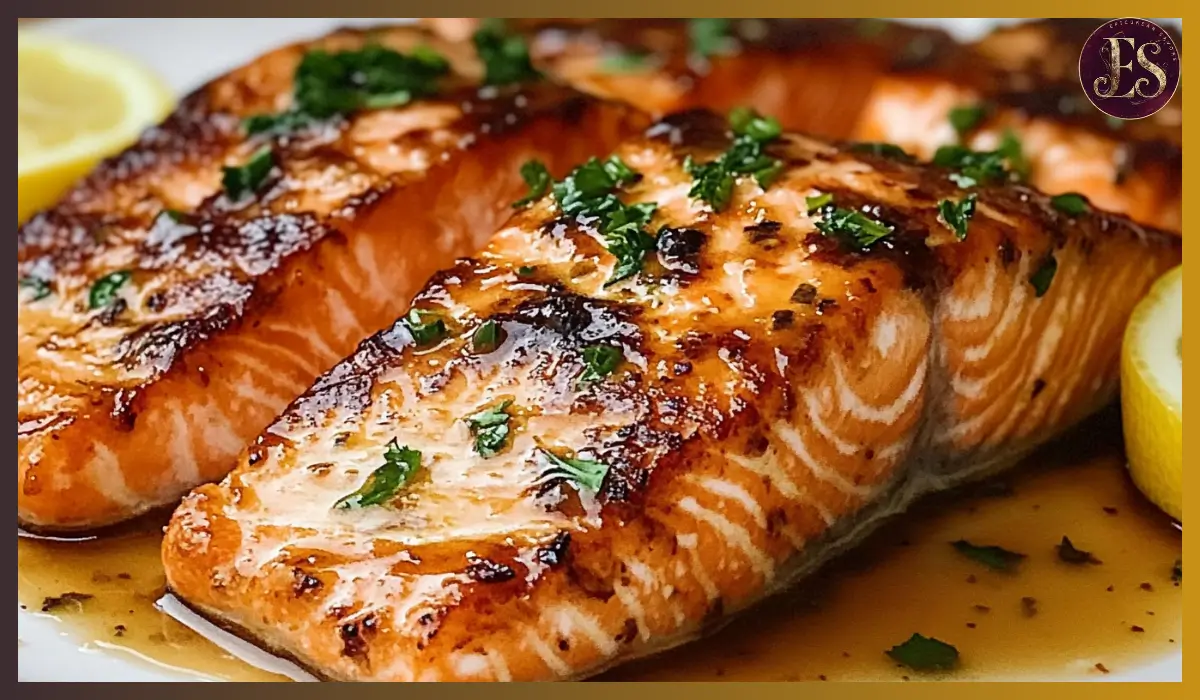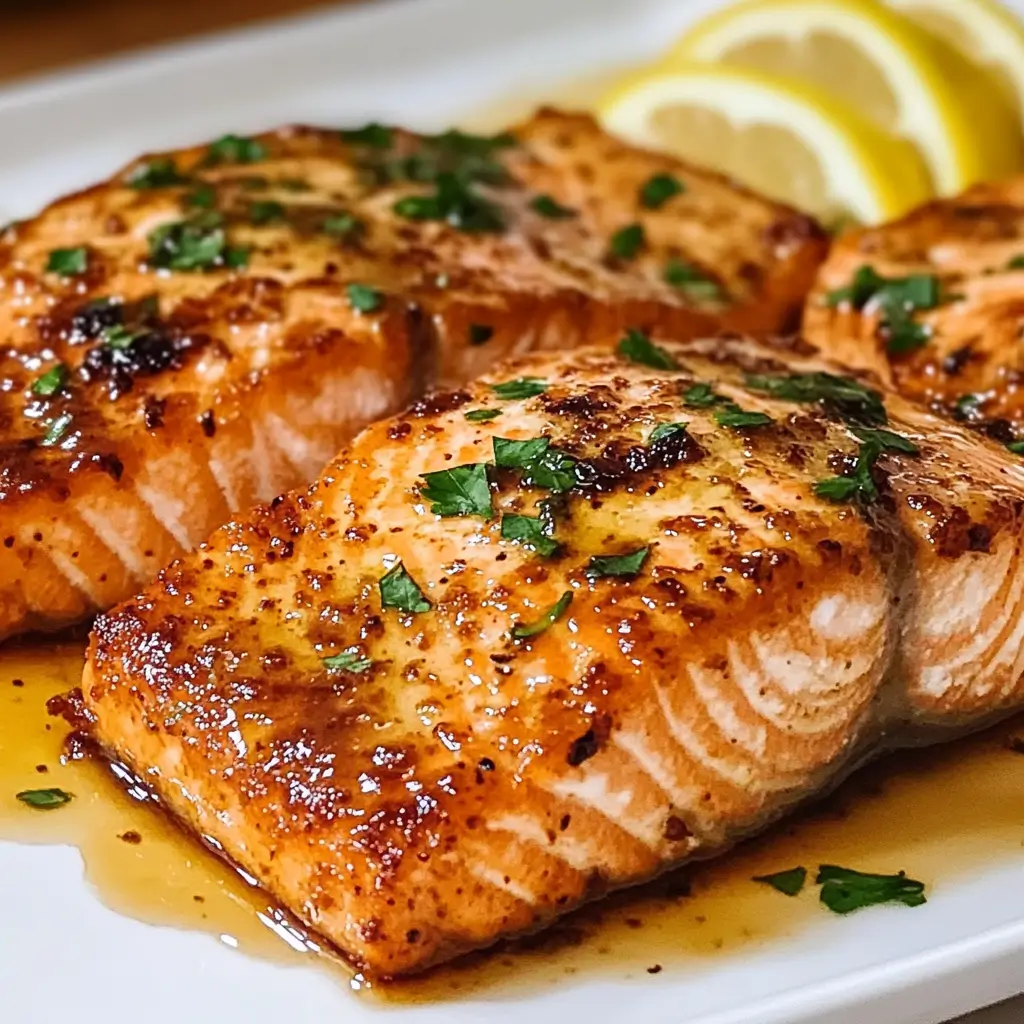When you think about a perfectly cooked, flaky, and flavorful salmon fillet, the kind that leaves you satisfied but still craving more, it’s hard not to think about the Texas Roadhouse salmon. There’s something magical about how their salmon is always so tender on the inside yet slightly crispy on the outside, infused with just the right amount of spices and a refreshing hint of lemon. The good news? You can recreate that magic right in your kitchen with just a few basic ingredients and simple techniques.
This recipe is perfect for those busy weeknights when you want something healthy and delicious without spending hours in the kitchen. Plus, it’s versatile enough to be served as a fancy dinner for guests or just a comforting meal for yourself. What makes this salmon recipe truly special is its rich, bold flavor created by a well-balanced mix of spices. The paprika and cayenne pepper give it a mild heat, while the garlic, onion powder, and oregano provide depth and aroma.
I remember the first time I tried to replicate this dish at home. I was craving that restaurant-quality salmon but didn’t feel like heading out. After a bit of experimenting, I nailed the combination of spices and cooking method, and now it’s a regular part of my dinner rotation. The best part? It’s incredibly easy to make, and once you get the hang of it, you’ll never feel the need to order out again.
Why You’ll Love This Texas Roadhouse Salmon Recipe
There are so many reasons why this Texas Roadhouse Salmon recipe is a must-try. First of all, it’s incredibly simple to prepare. You don’t need any complicated techniques or fancy gadgets. Just a few ingredients, a baking sheet, and an oven. And if you love dishes that are low-maintenance but high-impact, this recipe is definitely for you.
The flavor of this salmon is another reason to fall in love. The spice rub creates a beautiful crust on the outside of the fillet, locking in all the juices while delivering a slightly smoky, spicy, and earthy flavor profile. The addition of fresh lemon juice brightens everything up and cuts through the richness of the fish, making each bite irresistibly delicious.
Also, this recipe is extremely versatile. You can easily tweak the spice mix to suit your own taste preferences. Not a fan of heat? Tone down the cayenne pepper or swap it for smoked paprika for a deeper, more robust flavor without the spiciness. If you’re feeling adventurous, you can even experiment with different herbs and spices to create your own signature version of this dish.
Another reason to love this recipe is how well it fits into various diets. It’s naturally gluten-free, low-carb, and packed with protein and healthy fats. If you’re following a specific eating plan or just trying to eat healthier, this salmon recipe is a fantastic addition to your repertoire.
Health Benefits
Salmon is one of the healthiest foods you can include in your diet. It’s loaded with essential nutrients that offer a wide range of health benefits, making it a fantastic choice for a well-balanced meal.
First and foremost, salmon is a powerhouse of omega-3 fatty acids, which are known for their anti-inflammatory properties. These healthy fats are excellent for heart health, reducing the risk of cardiovascular diseases, and promoting brain function. They also contribute to healthier skin and hair, making salmon a beauty-boosting food as well.
Additionally, salmon is rich in high-quality protein. Protein is essential for muscle repair, tissue health, and overall body maintenance. It’s particularly important if you’re following a fitness routine or trying to build muscle.
Salmon is also an excellent source of important vitamins and minerals. It’s high in Vitamin B12, which supports nerve function and helps produce DNA. It’s also a great source of Vitamin D, which plays a critical role in bone health and immune function.
Furthermore, salmon provides important minerals like selenium and potassium. Selenium acts as a powerful antioxidant, while potassium helps maintain healthy blood pressure levels.
Lastly, salmon can aid in weight management. Its high protein content keeps you feeling full longer, reducing the chances of overeating. And because it’s nutrient-dense yet relatively low in calories, it’s a smart choice for those looking to maintain or lose weight.
Preparation Time, Servings, and Nutritional Information
- Preparation Time: 10 minutes
- Cooking Time: 12-15 minutes
- Total Time: 25 minutes
- Servings: 2 servings
Nutritional Information (Per Serving):
- Calories: 380 kcal
- Protein: 34g
- Carbohydrates: 3g
- Fat: 25g
- Omega-3 Fatty Acids: Approximately 1.8g
- Vitamin D: 80% of the Recommended Daily Intake (RDI)
- Selenium: 70% of the RDI
Ingredients List
For the Salmon Fillets:
- Salmon Fillets: 2 (about 6 oz each)
- Olive Oil: 2 tbsp (or avocado oil or melted butter as alternatives)
- Lemon Juice: From 1 lemon (plus extra lemon slices for serving)
- Fresh Parsley: Chopped, for garnish
For the Spice Rub:
- Garlic Powder: 1 tsp
- Onion Powder: 1 tsp
- Paprika: 1 tsp (smoked paprika works well too)
- Dried Oregano: 1 tsp
- Cayenne Pepper: 1/2 tsp (adjust to taste)
- Salt: To taste (about 1/2 tsp)
- Black Pepper: To taste (about 1/4 tsp)
Step-By-Step Cooking Instructions
Preheat the Oven
- Preheat your oven to 400°F (200°C).
Make the Spice Rub
- In a small bowl, mix together garlic powder, onion powder, paprika, dried oregano, cayenne pepper, salt, and black pepper.
Prepare the Salmon
- Pat the salmon fillets dry with paper towels.
- Place the fillets on a parchment-lined baking sheet.
Season the Salmon
- Brush each fillet with olive oil or your preferred alternative.
- Sprinkle the spice mixture generously over the salmon, pressing gently so it sticks.
Add Lemon Juice
- Squeeze fresh lemon juice over the seasoned salmon.
Bake the Salmon
- Bake the salmon in the preheated oven for 12–15 minutes or until it flakes easily with a fork and is opaque in the center.
Rest and Serve
- Let the salmon rest for 2–3 minutes before serving.
- Garnish with chopped parsley and serve with extra lemon slices.
How to Serve
Serving your Texas Roadhouse salmon is as much about presentation as it is about flavor. This dish shines on its own, but pairing it with the right sides elevates the experience.
Serving Suggestions:
- Over Rice: Fluffy white rice or wild rice complements the bold flavors of the salmon.
- With Vegetables: Serve alongside roasted asparagus, sautéed green beans, or steamed broccoli for a complete meal.
- On a Salad: Flake the salmon and place it over a fresh salad with mixed greens, cherry tomatoes, and a light vinaigrette.
- With Mashed Potatoes: Creamy mashed potatoes balance the spiciness of the salmon.
- As a Sandwich: Tuck the salmon into a toasted bun with lettuce, tomato, and a tangy mayo sauce.
The bright, citrusy notes from the lemon, combined with the spice rub, make this salmon a versatile main course. It pairs well with hearty sides or light, fresh salads, depending on your preference.
Pairing Suggestions
Pairing your Texas Roadhouse salmon with the right side dishes and beverages can make your meal truly unforgettable.
Side Dish Ideas:
- Garlic Mashed Potatoes: Creamy, buttery potatoes balance the robust spice of the salmon.
- Coleslaw: A crunchy, tangy coleslaw adds freshness and cuts through the richness.
- Roasted Vegetables: Try roasted carrots or Brussels sprouts for a hearty, healthy complement.
- Caesar Salad: Crisp romaine with a zesty Caesar dressing pairs beautifully with the seasoned salmon.
- Quinoa Salad: A light, protein-packed salad with cherry tomatoes and avocado complements the dish well.
Beverage Pairings:
- Iced Tea: A refreshing, slightly sweet iced tea pairs wonderfully with the bold flavors.
- Sparkling Water with Lemon: A fizzy, citrusy drink to cleanse the palate.
- Herbal Lemonade: The tartness of lemonade enhances the citrus in the dish.
Storage, Freezing & Reheating Instructions
Storing leftover salmon properly ensures you can enjoy it later without losing flavor or texture.
Storing:
- Allow the salmon to cool to room temperature.
- Store in an airtight container and refrigerate for up to 3 days.
Freezing:
- Wrap individual portions tightly in plastic wrap, then place them in a freezer-safe bag.
- Freeze for up to 3 months.
- Label with the date to keep track of freshness.
Reheating:
- Oven Method: Preheat to 275°F, cover the salmon with foil, and bake for 10–15 minutes.
- Microwave Method: Use a microwave-safe dish and heat on low in 30-second intervals until warmed through.
- Skillet Method: Heat gently over low heat with a splash of water to retain moisture.
Tips for Best Results:
- Avoid reheating at high temperatures to prevent the salmon from drying out.
- Add a squeeze of fresh lemon after reheating to refresh the flavor.
Common Mistakes to Avoid
1. Overcooking the Salmon
Salmon cooks quickly, and leaving it in the oven too long can result in a dry, tough texture. Keep an eye on it and check for doneness at around 12 minutes.
2. Using Too Much Oil
While oil helps create a crispy crust, too much can make the salmon greasy. Use just enough to lightly coat the fillets.
3. Not Patting the Salmon Dry
If the salmon is too moist, the spice rub won’t adhere well, and it may steam rather than roast. Pat the fillets dry with paper towels before seasoning.
4. Skipping the Resting Time
Letting the salmon rest for a few minutes after baking allows the juices to redistribute, keeping the fish moist. Skipping this step may cause the salmon to lose its juices when cut.
5. Neglecting to Adjust Spice Level
Cayenne pepper adds heat, but it can be overpowering if not balanced well. Start with a small amount and adjust according to your taste preferences.
Pro Tips
1. Choose Fresh Salmon
For the best flavor, choose fresh, high-quality salmon. Look for vibrant, firm fillets with a mild scent.
2. Season Generously
Don’t be afraid to use a generous amount of seasoning. The spices create a flavorful crust that enhances the salmon’s natural taste.
3. Use a Meat Thermometer
To ensure perfect doneness, use a thermometer. The internal temperature should reach 145°F for safe consumption.
4. Rest Before Serving
Allowing the salmon to rest for a few minutes after baking ensures that it remains juicy and flavorful.
5. Experiment with Spice Variations
Try swapping the cayenne pepper with smoked paprika for a smoky twist or adding a touch of brown sugar for a hint of sweetness.
Frequently Asked Questions (FAQs)
1. Can I Use Frozen Salmon?
Yes, but make sure it is fully thawed and patted dry before seasoning to avoid excess moisture.
2. Can I Cook This on the Grill Instead?
Absolutely! Preheat the grill to medium-high heat, and grill the salmon for 4–6 minutes per side or until the fish flakes easily.
3. What Can I Use Instead of Olive Oil?
Avocado oil, canola oil, or melted butter are great alternatives that still provide moisture and help the spices adhere.
4. How Do I Know If the Salmon Is Done?
The fish should flake easily with a fork, and the internal temperature should reach 145°F. The color will change from translucent to opaque.
5. Can I Make This Dish Spicier?
Yes, increase the amount of cayenne pepper or add red pepper flakes to the seasoning mix.
6. Can I Use a Different Type of Fish?
Yes, trout, cod, or halibut are excellent alternatives. Adjust cooking time according to the thickness of the fillets.
7. Is This Recipe Gluten-Free?
Yes, as long as your spices are gluten-free, this dish is naturally gluten-free.
8. Can I Marinate the Salmon?
While not necessary, marinating the salmon for 15–20 minutes with the spice rub and a little lemon juice can intensify the flavors.
9. What Side Dishes Work Best?
Roasted vegetables, mashed potatoes, or a crisp green salad are ideal pairings.
10. How Do I Keep the Salmon Moist When Reheating?
Add a little water or broth when reheating and cover the dish to trap steam and prevent drying out.
Conclusion & Call to Action
Congratulations! You’ve just mastered the Texas Roadhouse Salmon recipe, a simple yet incredibly flavorful dish that brings the restaurant experience right to your home. The perfectly seasoned, flaky salmon with a hint of citrus is sure to become a family favorite.
Whether you’re cooking for a quick weeknight meal or impressing guests at a dinner party, this salmon dish is a surefire hit. Remember, the key is to use fresh ingredients, balance the spices, and cook the salmon just until it’s done to retain its moist, tender texture.
Give this recipe a try, and let me know how it turned out for you! Did you make any creative tweaks or serve it with your favorite sides? I’d love to hear your experience. Feel free to share your thoughts and tips in the comments below or tag me on social media with your creations.
Happy cooking, and enjoy your flavorful, homemade Texas Roadhouse salmon!
Print
Texas Roadhouse Salmon
- Total Time: 25 minutes
- Yield: 2 servings
- Diet: Gluten Free
Description
This Texas Roadhouse Salmon Recipe is your go-to guide for a perfectly cooked, flavorful salmon that’s crispy on the outside and juicy on the inside. With a blend of smoky, spicy, and citrusy flavors, this dish is easy to prepare and perfect for both weeknight dinners and special occasions.
Ingredients
-
Salmon Fillets: 2 (about 6 oz each)
-
Olive Oil: 2 tbsp (or avocado oil/melted butter as alternatives)
-
Lemon Juice: From 1 lemon
-
Fresh Parsley: Chopped, for garnish
Spice Rub:
-
Garlic Powder: 1 tsp
-
Onion Powder: 1 tsp
-
Paprika: 1 tsp
-
Dried Oregano: 1 tsp
-
Cayenne Pepper: 1/2 tsp (adjust to taste)
-
Salt: To taste (about 1/2 tsp)
-
Black Pepper: To taste (about 1/4 tsp)
Instructions
- Preheat Oven: Preheat to 400°F (200°C).
- Prepare Spice Rub: Mix garlic powder, onion powder, paprika, oregano, cayenne pepper, salt, and black pepper.
- Prepare Salmon: Pat salmon fillets dry and place them on a parchment-lined baking sheet.
- Season: Brush fillets with olive oil and generously coat with the spice rub.
- Add Lemon Juice: Squeeze fresh lemon juice over the seasoned fillets.
- Bake: Bake for 12–15 minutes until salmon flakes easily with a fork.
- Garnish & Serve: Rest for 2–3 minutes, garnish with parsley, and serve with lemon slices.
Notes
- For a smoky twist, use smoked paprika instead of cayenne pepper.
- To prevent drying, avoid overcooking the salmon.
- Serve with rice, salad, or mashed potatoes for a complete meal.
- Prep Time: 10 minutes
- Cook Time: 15 minutes
- Category: Main Dish
- Method: Baking
- Cuisine: American


